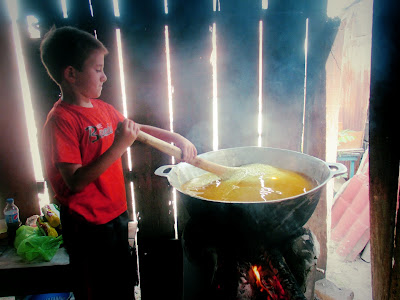Anthropology and missiology often go hand-in-hand. It is important to understand the host culture. Getting a grasp on what makes a people who they are does wonders on personal relationships. We were granted the privilege to see first-hand an age old tradition; the making of tamales. A tradition that dates back to pre-historic times even before the Mayan civilization. Our church ladies decided to sell tamales as a fundraiser, they made over 200 and sold them all in a matter of minutes!! I found the whole process very intriguing and wanted to share with our readers some insights into how this food is prepared.
Key to the whole thing is a corn meal based dough (made from dent corn not sweet corn). A local miller ground the corn for us. Certain spices are ground into the corn meal.
Vegetable oil is prepared to be cooked into the corn meal.
The corn meal is then mixed together with the vegetable oil and heated over an open fire. The smoke and heat in this little kitchen hut was an experience all its own. You have to continually stir so none of the corn meal sticks to the bottom and burns. We all took turns stirring the pot.
While the corn meal is heating, other people are washing hundreds of plantain leaves (similar to banana leaves). With wet rags they wipe off a milky substance on both sides of the leaf. Corn and plantain were vital to the Mayas and are still a staple food used by Hondurans today.
All the cleaned leaves ready to be used.
After the corn meal is heated and mixed with the oil, then it is removed off of the fire and another pot is heated. This pot contains the meat the filling that will go inside the tamales. There is a wide range of fillings used depending on the country. In our case they used potatoes, a spice called achiote (annatto), and chicken or pork.
The achiote spice comes from these seeds. The taste is described as "slightly peppery with a hint of nutmeg".
The meat and filling is left to cook on the fire.
After the corn meal is heated, the meat is cooked and the leaves are all washed then it is time to "pack" the tamales. Three or four plantain leaves are laid out on the table and then a good size spoon full of corn meal is placed in the corner.
Then the filling is placed in the center.
Then it is carefully wrapped in the leaves.
The little tamales are then tied up like a Christmas gift using strands of bark from the plantain tree. The strands are first soaked in water to make them more pliable and then cut to length. They are careful to not tie the tamale too tight neither too loose so they don't burst open or spill out while they are being steamed.
Once all the tamales are wrapped and ready, then another large pot is prepared to steam them. They line the bottom of the bottom with some small sticks and more plantain leaves.
Then the pot is filled with the tamales and water is poured over them.
The pot is then covered with plastic and left to steam for about two or so hours.
The kitchen felt like a sauna!
The outside of the little kitchen.
The finished product! Ready to be sold and eaten! Mmmm so good and a great money maker! Another activity is planned for later this month. Hot tamales, hot tamales, get'em while their hot!





















1 comments:
Wow! That is interesting..I wished we could have watched that when we were there...
Post a Comment